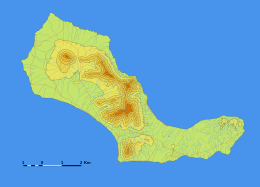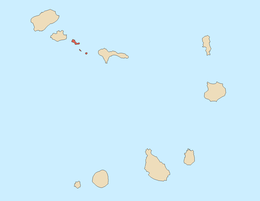Santa Luzia, Cape Verde

Terrain map of Santa Luzia
|
|
| Geography | |
|---|---|
| Location | Atlantic Ocean |
| Coordinates | 16°45′41″N 24°44′38″W / 16.76139°N 24.74389°W |
| Archipelago | Cape Verde |
| Area | 35 km2 (14 sq mi) |
| Length | 12.3 km (7.64 mi) |
| Width | 5.3 km (3.29 mi) |
| Highest elevation | 395 m (1,296 ft) |
| Highest point | Monte Grande (also as Topona) |
| Administration | |
|
Cape Verde
|
|
| Concelhos (Municipalities) | São Vicente |
Santa Luzia is an island of the Barlavento archipelago in Cape Verde located between São Nicolau and São Vicente, the channel of Santa Luzia separates the island of São Vicente and is 8 km long. The area is 35 km² (some reads 34 km²). Like all Cape Verdean islands, it island is of volcanic origin. The highest point is Monte Grande or Topona elevating 395 m, the second elevating 344 m and the third elevating 337 m, other mountain tops include Agua Doce or Agua Dolce (315 m) and the fifth tallest is Monte Espia located to the south elevating 294 m. Hills named Crioulo (also as Creoulo) is in the east and elevates 85 m and Topino da Praia elevating 19 m. Santa Luzia is 12.3 km long and 5.3 km wide.
It is administratively a part of the municipality of São Vicente (sometimes called municipality of São Vicente and Santa Luzia), the abandoned settlement is a part of the village of Ribeira do Calhau located in the east of São Vicente. Until the late-19th century, it belonged to the municipality of São Nicolau along with its eastern islets.
Along with the islets of Branco and Raso, they are on the tentative list of UNESCO's World Heritage Sites, one of eight in Cape Verde that are nominated, no date is set.
The seamount was formed in around 122 million years ago from the older ocean crust during the Cretaceous Period.
During the Ice Age, Santa Luzia along with São Vicente and Santo Antao were a part of the Northwestern Island which was the size of about 1,500 km2. Around 5,000 to 4,000 BC, the island split and the islands of Santa Luzia and the islets of Ilhéu Branco and Raso formed after sea levels rose in the Late Ice Age.
...
Wikipedia

